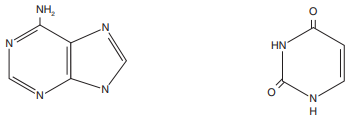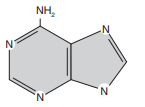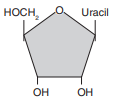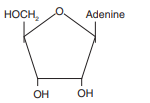1. 
The diagrams represent the nitrogenous bases. Identify the correct combination.
a) A→Adenine; B→Thymine
b) A→Guanine; B→Uracil
c) A→Adenine; B→Uracil
d) A→Guanine; B→Thymine
Explanation: A→Adenine; B→Uracil
2. Which one of the following is the diagrammatic representation of a nucleotide?
a) 
b) 
c) 
d) 
Explanation:

3. Which one is correct about the following diagram? 
a) It is a nucleotide.
b) It contains pyrimidine nitrogen base.
c) It is used to form DNA.
d) It is used to form RNA.
Explanation: It is used to form RNA.
4. Which one is correct about DNA?
a) DNA exist as double helix.
b) Two strands of polynucleotide in DNA are antiparallel.
c) The nitrogen bases are projected more or less perpendicular to this backbone but face
inside.
d) All of above
Explanation: All of above
5. At each step of an ascent in a B-DNA double helical structure, the strand turns _________.
a) 36°
b) 72°
c) 90°
d) 18°
Explanation: At each step of an ascent in a B-DNA double helical structure, the strand turns 36°
6. One full turn of B-DNA helix strand would involve how many base pairs?
a) 12
b) 8
c) 10
d) 20
Explanation: 10 base pairs
7. Select the incorrect statement from the following:
a) \[N_{2}\]-bases (A, G, C, T, U) have heterocyclic rings.
b) In most of the organisms, the DNA is genetic material
c) Adenylic acid is nucleoside
d) The rise per base pair in B-DNA is 3.4A°.
Explanation: "Adenylic acid is nucleoside". This is incorrect.
8. There are _____ hydrogen bond between A and T, and _____ hydrogen bond between G and C.
a) 2,2
b) 3,3
c) 2,3
d) 3,2
Explanation: There are 2 hydrogen bond between A and T, and 3 hydrogen bond between G and C.
9.Plants produce an enormous diversity of substances that have no apparent roles in growth and
development processes and are classified under the heading of
a) Primary metabolites
b) Secondary metabolites
c) Necessary metabolites
d) Tertiary metabolites
Explanation: Secondary metabolites
10. Which one of the following is a secondary metabolite?
a) Amino acid
b) Sugar
c) Flavonoides and antibiotics
d) Protein
Explanation: Flavonoides and antibiotics